One hundred and forty-two years ago today on October 27th, 1877, the three-masted iron-hulled merchant sailing ship Elissa was launched in Aberdeen, Scotland. She is now a museum ship at the Texas Seaport Museum. In honor of her birthday, here is a repost of a video by Mike Headley of the Elissa on her yearly sail.
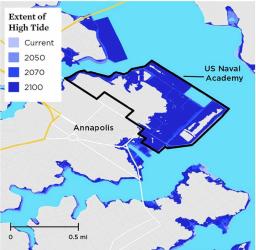 Climate change deniers can choose to ignore the overwhelming scientific consensus of man-made climate change all they want. How long they will continue to deny the evidence before their own eyes? Two immediate examples — Fox Island and the US Naval Academy.
Climate change deniers can choose to ignore the overwhelming scientific consensus of man-made climate change all they want. How long they will continue to deny the evidence before their own eyes? Two immediate examples — Fox Island and the US Naval Academy.
For 40 years, the Chesapeake Bay Foundation has run educational programs on Fox Island, an island between the Tangier and Pocomoke sounds. This is the last year, however. Rising sea levels have effectively washed the island away.
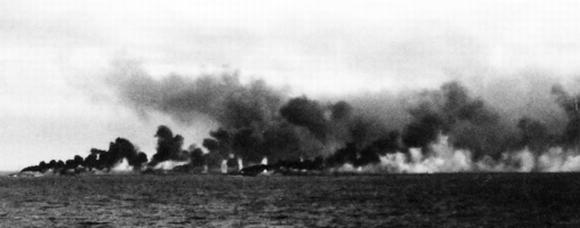 The Battle of Leyte Gulf was fought seventy-five years ago this week between the US and Australian navies and the Imperial Japanese Navy. It was the largest naval battle of World War II and by some standards the largest naval battle in history. Fought between October 23-26, 1944, it was actually a series of battles that spanned over more than 100,000 square miles of sea and involved more than 800 ships and 1,800 aircraft. The battle of Leyte Gulf was a major allied victory and effectively destroyed the Imperial Japanese Navy as a fighting force.
The Battle of Leyte Gulf was fought seventy-five years ago this week between the US and Australian navies and the Imperial Japanese Navy. It was the largest naval battle of World War II and by some standards the largest naval battle in history. Fought between October 23-26, 1944, it was actually a series of battles that spanned over more than 100,000 square miles of sea and involved more than 800 ships and 1,800 aircraft. The battle of Leyte Gulf was a major allied victory and effectively destroyed the Imperial Japanese Navy as a fighting force.
The Battle off Samar, fought on October 25, 1942, seventy-five years ago today, saved the landings at Leyte Gulf from likely destruction. The powerful US Navy 3rd fleet had been lured north by a decoy Japanese force, leaving the Leyte landing beaches protected only by three small escort carrier task forces designated by their call signs, Taffy 1, 2 and 3.
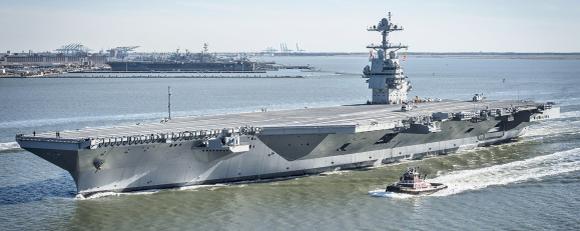 Back in January, Richard V. Spencer, Secretary of the Navy, made a promise to President Trump that the advanced weapons elevators on the new carrier USS Gerald R. Ford would be operational by the end of the summer or the president should fire him. The new carrier, costing $13 billion dollars, the most expensive warship ever built, cannot operate in combat without the electromagnetically powered elevators that carry munitions from the ship’s magazine to the hangar.
Back in January, Richard V. Spencer, Secretary of the Navy, made a promise to President Trump that the advanced weapons elevators on the new carrier USS Gerald R. Ford would be operational by the end of the summer or the president should fire him. The new carrier, costing $13 billion dollars, the most expensive warship ever built, cannot operate in combat without the electromagnetically powered elevators that carry munitions from the ship’s magazine to the hangar.
Without functional elevators, Rep. Elaine Luria (D-Va.), a Navy veteran, recently described the new carrier as a “$13-billion nuclear-powered floating berthing barge.”
 Acme Oyster House has been a New Orleans icon since 1910. My first memory of oysters on the half shell was slurping down a dozen at Acme more than a half-century ago. So, I was alarmed to read that Acme has, at least temporarily, stopped serving raw oysters because they cannot get enough local oysters.
Acme Oyster House has been a New Orleans icon since 1910. My first memory of oysters on the half shell was slurping down a dozen at Acme more than a half-century ago. So, I was alarmed to read that Acme has, at least temporarily, stopped serving raw oysters because they cannot get enough local oysters.
“If we can’t get Louisiana oysters, we’re not going to serve raw oysters at all,” Acme CEO Paul Rotner said.
“Every oyster we get in, we’re directing them to the grill so we can at least keep that product available,” he said. “And I’m not sure how long we can even keep doing that.”
The Louisiana oyster crop has been devastated by this spring’s record flooding from the Mississippi River. Continue reading
The RV Petrel has located the wreckage of the Japanese aircraft carrier Akagi, sunk in the Battle of Midway in June 1942. The ship is the second of two sunken Japanese carriers that the Petrel has located two days apart. They had previously located the carrier Kaga. The Akagi and the Kaga were two of four large carriers sunk in the battle, which was considered a turning point in the Pacific conflict in WWII. Both carriers had participated in the attack on Pearl Harbor on December 7, 1941.
The Akagi was found in the Papahanaumokuakea Marine National Monument, sitting upright in a debris field, in nearly 18,000 feet of water, or almost 3 nautical miles deep, more than 1,300 miles northwest of Pearl Harbor.
Researchers Discover Second Long-Lost Japanese Warship From World War II Battle Of Midway

Joseph Conrad
A repost from 2010 in honor of Trafalgar Day, commemorating Nelson’s great victory over the combined French and Spanish fleets on this day in 1805. I have always been struck that of all the commentary I have read on the famous battle, Joseph Conrad is the only writer I am aware of to have asked one simple question — what if the wind had changed? How would a wind shift have altered the history which we all take for granted?
The final essay in Joseph Conrad’s wonderful, if somewhat odd book, The Mirror of the Sea, is entitled “The Heroic Age.” It starts out rather disappointingly as a paean to Nelson. There is nothing wrong with praising Nelson, except that everyone does it, so another bit of hagiography doesn’t necessarily add anything new.
Then, well into the essay, Conrad does something rather remarkable. He wonders what would have happened if the wind had shifted on that morning of the 21st of October.
Continue reading
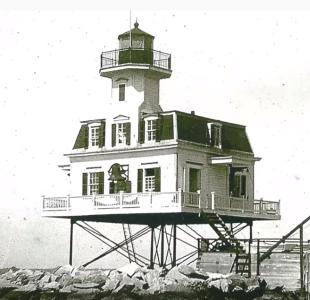 The Long Beach Bar Light was built in 1871 as a “screwpile” lighthouse on the North Fork of Eastern Long Island, off Orient, New York. Because a screwpile lighthouse is a lighthouse that stands on thin piles that are screwed into a sandy bottom, many thought the lighthouse looked like a water bug, earning it the nickname “Bug Light.”
The Long Beach Bar Light was built in 1871 as a “screwpile” lighthouse on the North Fork of Eastern Long Island, off Orient, New York. Because a screwpile lighthouse is a lighthouse that stands on thin piles that are screwed into a sandy bottom, many thought the lighthouse looked like a water bug, earning it the nickname “Bug Light.”
It wasn’t a screwpile lighthouse for long, however. The winter ice threatened to rip out the piles and so a breakwater was built around the base of the lighthouse foundation which was later additionally reinforced with a concrete caisson.
When Simeon Lowell moved his boat-building business to Amesbury, Massachusetts in 1793, I wonder whether he could have possibly imagined that the boat shop would still be producing boats, dories, and skiffs 226 years later. Lowell’s Boat Shop is the oldest continuously operating boat shop in the United States and is recognized as the birthplace of the legendary Banks fishing dory. Here is a short video that looks at the history and the legacy of Lowell and his dories.
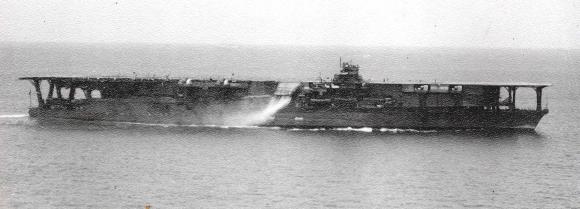
Japanese Carrier Kaga
Paul Allen, the billionaire co-founder of Microsoft, died almost exactly a year ago. Nevertheless, his passion for underwater archeology lives on in the operation of the Research Vessel Petrel, which is fully funded by Allen’s estate. The ship’s mission is to explore historically significant wrecks at challenging depths and conditions. A precondition set by Allen is for discovered wrecks to be respected as war graves and their locations kept secret but known only to national governments and museums.
Their latest find is the wreckage of the Japanese aircraft carrier Kaga which was sunk in the Battle of Midway in June of 1942. Kaga was one of four large Japanese carriers sunk during the battle. Kaga had taken part in the Pearl Harbor raid of December 1941.
The crew of the RV Petrel located the wreck sitting upright 5,400 meters (almost 3 nautical miles) below the surface.
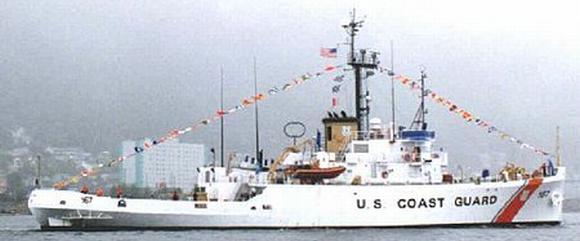 The strange saga of the USCGC Acushnet continues. Back in 2011, Acushnet, the oldest serving cutter in the U.S. Coast Guard was put up for sale. She was purchased by a con-man named Vernon Officer who bought the cutter using someone else’s money. The cutter was subsequently abandoned and Mr. Officer was imprisoned for cheating an elderly widow out of her life savings. The cutter, however, has been cared for and is reportedly in reasonably good shape. She is currently for sale for $250,000.
The strange saga of the USCGC Acushnet continues. Back in 2011, Acushnet, the oldest serving cutter in the U.S. Coast Guard was put up for sale. She was purchased by a con-man named Vernon Officer who bought the cutter using someone else’s money. The cutter was subsequently abandoned and Mr. Officer was imprisoned for cheating an elderly widow out of her life savings. The cutter, however, has been cared for and is reportedly in reasonably good shape. She is currently for sale for $250,000.
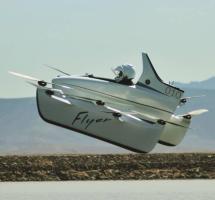 Two years ago, we posted about an all-electric “flying car” which was actually more of a single passenger seaplane, as it took off and landed on the water. The startup named Kitty Hawk has major funding from Larry Page, the billionaire co-founder of Google. Now Kitty Hawk is seeking to test their updated version of the craft in New York Harbor. Whether or not this is a good idea remains to be seen.
Two years ago, we posted about an all-electric “flying car” which was actually more of a single passenger seaplane, as it took off and landed on the water. The startup named Kitty Hawk has major funding from Larry Page, the billionaire co-founder of Google. Now Kitty Hawk is seeking to test their updated version of the craft in New York Harbor. Whether or not this is a good idea remains to be seen.
Jersey Digs reports that the company filed plans with the New Jersey Department of Environmental Protection (NJDEP) in connection with a proposal to bring its Flyer aircraft to Jersey City’s Hudson River waterfront. Continue reading
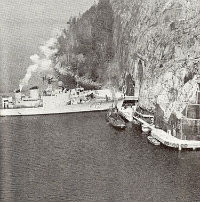
HSwMS Sundsvall entering one of the openings to the naval base
The Swedish Navy’s headquarters is returning to a vast underground naval base beneath Muskö in the Stockholm Archipelago in response to a perceived threat of a Russian attack. The vast underground cold war fortress can shelter warships and submarines and was designed to withstand a nuclear blast. The facility includes two shipyards and is connected to the mainland by a series of causeways and a tunnel.
The Guardian quotes Niklas Granholm, a senior analyst at the Swedish Defence Research Agency, saying “The move is based on the calculation that the Russians could use powerful weapons which demand the level of protection that only Muskö can provide.”
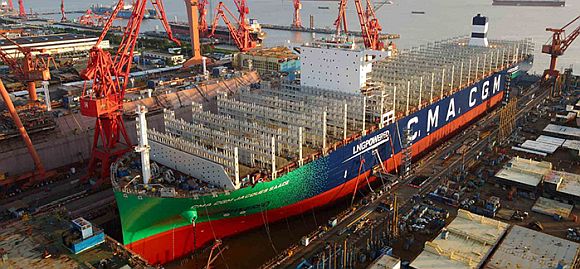 Last month, China’s Shanghai Jiangnan-Changxing Shipyard launched the CMA CGM Jacques Saadé, the first in a new fleet of nine French-flagged, 23,000-TEU, LNG-powered containerships that will join the group’s fleet in 2020 on the French Asia Line. Not only will the new ship be one of the world’s largest container ships when it goes into service, and it will also be the largest LNG powered container ship in the world. The ship will be powered by a Winterthur Gas & Diesel Ltd (WinGD) 12-cylinder X92DF dual-fuel low-speed engine, developing 63,840 kW (91,766 HP) at 80 rpm.
Last month, China’s Shanghai Jiangnan-Changxing Shipyard launched the CMA CGM Jacques Saadé, the first in a new fleet of nine French-flagged, 23,000-TEU, LNG-powered containerships that will join the group’s fleet in 2020 on the French Asia Line. Not only will the new ship be one of the world’s largest container ships when it goes into service, and it will also be the largest LNG powered container ship in the world. The ship will be powered by a Winterthur Gas & Diesel Ltd (WinGD) 12-cylinder X92DF dual-fuel low-speed engine, developing 63,840 kW (91,766 HP) at 80 rpm.
For nearly 700 years, fishermen have been trawling for shrimp from horseback in the small town of Oostduinkerke, on the Belgian coast. Whether the tradition is dying or enduring may be the subject of debate. It is, however, both singular and fascinating. Here is a short video that describes Belgian fishing on horseback.
 The North Korean handysize bulk carrier Wise Honest has been sold in a sealed bid auction. The proceeds of the auction will go to compensate the family of Otto Warmbier, the American student who died in 2017 shortly after being released in a vegetative state by North Korea after being tortured for allegedly trying to steal a propaganda poster, as well as the family of the Rev. Dong Shik Kim, who was kidnapped, tortured and executed by North Korean agents in 2000.
The North Korean handysize bulk carrier Wise Honest has been sold in a sealed bid auction. The proceeds of the auction will go to compensate the family of Otto Warmbier, the American student who died in 2017 shortly after being released in a vegetative state by North Korea after being tortured for allegedly trying to steal a propaganda poster, as well as the family of the Rev. Dong Shik Kim, who was kidnapped, tortured and executed by North Korean agents in 2000.
The 580-foot, 17,601-ton single-hull bulk carrier was seized in April 2018 by Indonesian authorities for violating international sanctions. The ship was taken over by the US in May of 2019 and was towed to American Samoa. In July, it was sold under the orders of federal judges in New York and Washington.
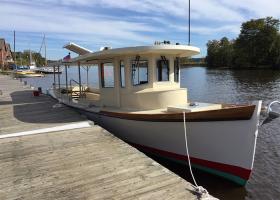
Solaris, docked at the Hudson River Maritime Museum in Kingston’s Rondout Basin
The Solaris, a solar-powered tour boat owned by the Hudson River Maritime Museum in Kingston, NY will provide trips across the Hudson River on Saturday and Sunday, October 19 and 20. (They also previously offered trips at the end of September.)
The Mid-Hudson News reports that the boat will run every hour, leaving the Newburgh Washington Street Boat Launch at 2 Washington Street. It will depart Beacon from the Beacon Institute Dock on the waterfront near the Metro-North Train Station, every half-hour. The crossing takes 20 minutes.
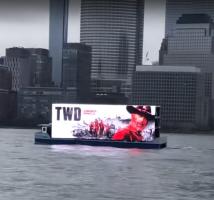 Roughly a year ago, a tug pulling a barge carrying a double-sided 60 foot long LED screen blasting animated, high-definition digital ads for everything from beer to movies, appeared on the Hudson and East Rivers, threatening to turn the riverscape into another neon Times Square. The company which operated the barge, Ballyhoo Media, proclaimed their barge “the future of digital billboard advertising.” Many New Yorkers considered it to be a nuisance and an eyesore.
Roughly a year ago, a tug pulling a barge carrying a double-sided 60 foot long LED screen blasting animated, high-definition digital ads for everything from beer to movies, appeared on the Hudson and East Rivers, threatening to turn the riverscape into another neon Times Square. The company which operated the barge, Ballyhoo Media, proclaimed their barge “the future of digital billboard advertising.” Many New Yorkers considered it to be a nuisance and an eyesore.
Since then there have been lawsuits and legislation to restrict the barge and the others like it. At the same time, the Ballyhoo CEO Adam Shapiro promised to fight back and indeed flout the actions taken against the floating advertizements.
For all the sturm und drang, the battle appears now to be over and the billboard barge has lost. Gothamist reports:
 Late season cruises have their own inherent risks. In the case of a recent cruise on the Norwegian Spirit these risks were compounded by the remnants of Hurricane Lorenzo, now a post-tropical storm, which was pounding the Atlantic Coast of Europe.
Late season cruises have their own inherent risks. In the case of a recent cruise on the Norwegian Spirit these risks were compounded by the remnants of Hurricane Lorenzo, now a post-tropical storm, which was pounding the Atlantic Coast of Europe.
The 2,016 passenger Norwegian Spirit left Southampton on September 27th, bound for a two-week cruise with nine port calls in the Netherlands, Norway, Iceland, and Ireland. It was billed as the “Mystical Fjords” cruise. For many of its passengers, it would become the “cruise from hell,” featuring missed port calls, spoiled food, and overflowing toilets. Before it was all over, the passengers were in a near mutiny and close to rioting
 One of the most interesting accounts of a sea serpent is that of the HMS Daedalus in 1848. When sailing in the South Atlantic, some 300 miles from the coast of present-day Namibia, officers and crew aboard the ship saw what they described as an enormous serpent swimming with its head four feet above the water and roughly another sixty feet of the creature extending back in the sea. Captain McQuahoe also said that “[The creature] passed rapidly, but so close under our lee quarter, that had it been a man of my acquaintance I should have easily have recognized his features with the naked eye.” According to seven members of the crew, it remained in view for around twenty minutes. Lt. E.A. Drummond recorded the events in his diary the day he observed them and also made sketches of what he saw.
One of the most interesting accounts of a sea serpent is that of the HMS Daedalus in 1848. When sailing in the South Atlantic, some 300 miles from the coast of present-day Namibia, officers and crew aboard the ship saw what they described as an enormous serpent swimming with its head four feet above the water and roughly another sixty feet of the creature extending back in the sea. Captain McQuahoe also said that “[The creature] passed rapidly, but so close under our lee quarter, that had it been a man of my acquaintance I should have easily have recognized his features with the naked eye.” According to seven members of the crew, it remained in view for around twenty minutes. Lt. E.A. Drummond recorded the events in his diary the day he observed them and also made sketches of what he saw.
What makes the sighting so unusual is the length of the observation, the number of witnesses and that several Royal Navy officers were among that number. Three professional drawings of the creature, based on the captain’s account, were later published. Sketches made by Lt. Drummond finally turned up in 1977.
